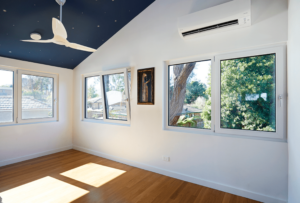Sleep is super important for good health and a good life. We know this but generally overlook how building design choices impact sleep quality.
An ASHRAE Journal article just published cites an Australia study which estimated the overall cost of sleep disorders in 2019 and 2020 to be USD$35.4 billion! “[T]he financial cost component was USD$10.0 billion … comprising health system costs, productivity losses, informal care and others. The study also found that the non-financial cost of USD$25.4 billion, which is associated with the loss of well-being, represented 3.2% of total Australian burden of disease for the year.”
That is a huge impact. I’d expect similar findings for Aotearoa New Zealand as we have similar building design prejudices. A well-designed Passive House home delivers many benefits that directly benefit the sleeping environment. First is greatly improved indoor air quality: fresh, filtered air via mechanical ventilation. Second is appropriate, stable temperatures and humidity levels.
There’s also a third way Passive House performance helps people get a good night’s sleep: being able to exclude noise from outside by closing high-performance windows. This is huge and often underestimated by homeowners until they experience the benefits for themselves. Thanks to mechanical ventilation, this benefit does not come at the cost of creating stale, stuffy air.
Some designers get it though. I know of projects in large Australian cities (like Thornleigh, pictured above) where triple-glazing has been specified for the purpose of acoustic insulation, not because their climate requires it for thermal insulation.
Unfortunately designing for better sleep is not generally well studied or understood.
“Ventilation, IEQ, and Sleep Quality in Bedrooms,” ASHRAE Journal June 2023, pg 38-41. Available online to subscribers only.
It discusses the importance of sleep for human health and well-being, particularly focusing on the impact of indoor environmental quality (IEQ) on sleep quality. It highlights the need for a holistic approach to understanding the factors that contribute to adequate sleep and the consequences of poor sleep quality on daily performance and learning. The final conclusion is we need to focus on it more and ASHRAE should revise their standards to include it.
See also this brief by the same authors which covers the implications of building design on sleep in useful detail.
